learn how
Ceramic Artist - Tiburcio Soteno Fernández - A Family's Story
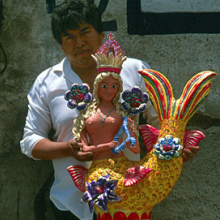
Mexican ceramics are an important part of modern life. The bustling town of Metepec, which lies less than 50 km from Mexico City, is famous for the scale and exuberance of its ceramic production. By tradition, most makers are male. Workshops are small and family-run.
The mermaid is a popular theme for the ceramic artists of Metepec. Tiburcio explains: "People often ask why we make mermaids when we live far from the sea."
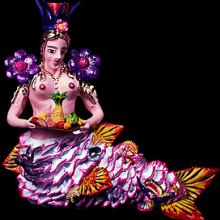
"You want to know about la sirena [the mermaid]? In the past, when there were rainstorms, the river Lerma would overflow. There was a belief, among local fishermen, that a beautiful woman would appear where the lightning struck.
Some fishermen were brave enough to search for her. According to legend, any fisherman who saw her beauty immediately fell in love and asked to marry her. The mermaid agreed, but imposed one condition..."
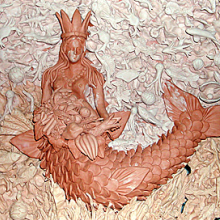
"The mermaid made each suitor promise that he would support all her children. 'What children?' he would think to himself. 'She is too young to have children.'
As each suitor made his promise, she would raise her arms. From her armpits came a torrent of water creatures: fish, frogs, water snakes... These were her children. The fishermen were horrified of course. They either ran away or died of shock."
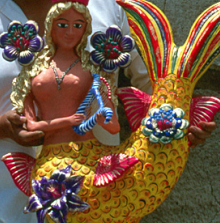
"All this was long ago. Our town has grown and the water has dried up. Roads and buildings have spread across the land where I played as a boy, and where farmers grew maize. Now the local water is piped to Mexico City.
But those who still believe in the mermaid have another explanation. There are old people in Metepec who say that someone stole the mermaid, and took her away to another place. When she left, much of our water went with her."
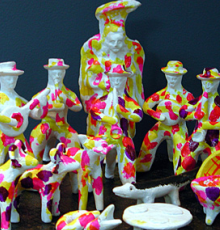
The finished cuadrilla is white-washed, then painted with bright colours. Figures include the person who hopes to be cured, the man on horseback with his lady, kings, musicians, dancers and a priest. Also present are the rainbow and the wind, natural elements associated with water and air.
The animal world is represented by a coyote, a dog, a serpent, a lizard and a sheep, all seen in this image in the foreground before a band of musicians. Saint Gabriel presides over the group. As Tiburcio says: "Es toda una vida." ["All life is here."]
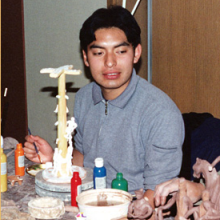
In Metepec, skills are passed down from generation to generation. Tiburcio has taught his working methods to his three sons. They now help Tiburcio, as he once helped his parents.
Carlos is Tiburcio's eldest son. Born in 1978, his work is already sought after by collectors. When Tiburcio was invited to Toronto to make a piece for the Gardiner Museum, Carlos came too. The piece he is painting here shows a children's game called 'El palo encebado' ['the greasy pole'].
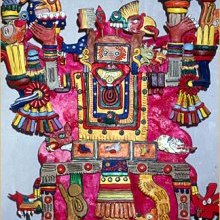
Carlos has inherited his father's manual dexterity and vivid imagination. Already, he is developing his own individual style and sense of colour. This 'tree of life', modelled by hand when Carlos was just twenty years of age, represents an Aztec deity.
During his visit to the Gardiner Museum, Carlos made another magnificent 'tree of life'. At its centre is a mermaid surrounded by waves and water creatures. These include exotic fish, shrimps, sea-turtles, abalone, sea horses, stingrays, octopus and oysters with pearls.
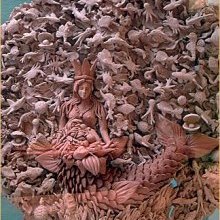
The mermaid holds a basket overflowing with melons, pineapples and other fruit; also cucumbers, broccoli, maize, squash and chile peppers.
Tiburcio is justly proud of his son. He tells us: "We older artists have high hopes of the young people who will follow in our footsteps. They will dream up new themes and ways of working. There is a revolution in progress."
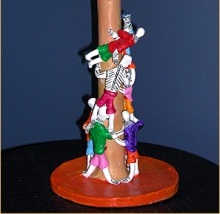
The game of 'el palo encebado' ['the greasy pole'] is played in Metepec during festivals. Two rival teams compete, each hoping to be the first to reach the top. Whoever succeeds in scaling the slippery pole will share out the prizes that hang so tantalisingly out of reach.
Carlos has shown the children as skeletons. This is not unusual in Mexico: during the festival of the Days of the Dead, the living are often represented as skeletons.
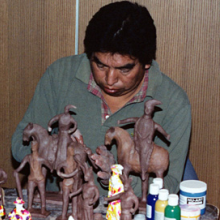
In Metepec, ceramics are almost always a male pursuit. Unusually, Tiburcio inherited his skill from his mother. Modesta Fernández learned her craft as a girl, when she was sent away from home to escape infection during an epidemic.
Today Tiburcio still sells many of the ceramic toys he remembers from his childhood. These include bulls, roosters, lions, rabbits and winged horses. He also makes the figures that were once used in traditional healing rituals.

The moulds used to make many of these figures are old and highly prized. Tiburcio hand-models smaller figures. Each healing set, known as a cuadrilla, comprises approximately 32 pieces. A partial set in progress is shown here, including the man on horseback with his lady.
As a child, Tiburcio was taught to respect these figures. He explains: "They are strange and mysterious. The cuadrilla has been very important for us. We were a poor family. I can still remember the healer who used to come for these figures."

"I used to ask my parents what the cuadrilla was for and how it was used. They explained that the healer needed it to cure the sick. He would use the figures to attract the sickness away from his patient. Then he would leave the figures in a distant spot, perhaps in the mountains."
"These figures are the transition between the sort of things we used to make and the things we make now. They are a bridge between the past and the present."